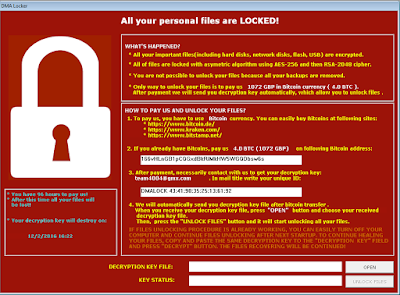You are probably on this page, because you came across a really disturbing message on your screen that said something about your files being encrypted, or you no longer having access to them – something along those lines. It probably also requested that you pay a certain amount for access to be granted again. To you. For your own files. Your own property. Talk about outrageous, huh?
If all of this sounds overly familiar, then you have been infected by one of the nastiest pieces of malware known as DMA Locker 3.0 , which is a type of ransomware. You can surely guess that the name is derived from the fact that a ransom is actually demanded in return for being able to use your computer as normal. Unfortunately, these types of viruses are extremely widespread and have been experiencing exponential growth over the past several years. Initially only present in Russia back in the nineties, ransomware is today a worldwide issue, spanning across every virtual inch of the globe. We have put together the below guide to help you remove the virus and deal with the encrypted files you may have, because removal alone will not solve the whole problem.
How was I infected?
It’s hard to say for sure, because ransomware is particularly stealthy and when it comes travelling with its best friend – a Trojan Horse, which is notorious for being exceptionally covert – detecting them proves nearly impossible. There are however known methods by which ransomware like DMA Locker 3.0 is distributed, and the most effective one seems to be via email. What happens is you receive an email (spam, for the most part) with either an attached file or a link inside. If you aren’t cautious, you proceed to download and open the file, because it might very well seem extremely harmless to you (for real now, how dangerous could a simple PDF or Word document be?). What you don’t know, is that the file has been injected with a Trojan, which will automatically download the ransomware onto your computer. Same goes for the link in the email – click on it and you will be redirected to some malicious website and things will follow the same scenario. Note that none of this will let you know of the processes taking place, so you probably won’t even suspect anything until it’s too late.
Luckily, you might have a chance, though. Depending on a few factors like the power of your processor and amount of data stored, your computer could become incredibly slow while DMA Locker 3.0 is at work. This should prompt you to open your Task Manage and sort the processes in it by memory used. DMA Locker 3.0 uses an awful lot of RAM, you see, therefore you should be able to see it somewhere at the top. Should this be the case, you need to shut down your system immediately and seek a professional to help.
Should I pay the ransom?
We advise you not to; at least because there’s no guarantee that it will help the situation. For all you know, those hackers might not even be thinking of sending you the decryption key, which you need in order to restore access to those files of yours. There’s also no way of being sure that the key they send will work for all of the encrypted files. We do not promise that our methods will work 100% either, but they at least won’t inflict any harm on your data. Aside from that, you should know that thanks to the miracles of the deep web, which offers a great degree of anonymity, these cyber criminals are practically unstoppable and a lot of the times cannot be tracked by the authorities. Do you really want to encourage them further by paying them to do what they’re doing?
How do I protect myself from DMA Locker 3.0 ?
Like it is with cyber security in general (as with pretty much anything else in life), common sense applies. If you want to avoid getting robbed at night, you’ll stay away from those dark allies, won’t you? So if you want to be safe from malware – don’t go browsing shady websites that might be teeming with viruses. Naturally, you shouldn’t download anything from them either, including the attachments in suspicious emails. And of course, you should always have an antivirus program running, as well as administer virus checks on a regular basis.
How to Remove DMA Locker 3.0
Well, it is possible to remove DMA Locker 3.0 manually from infected computer system, however its certainly not an easy task for the users specially if you not technically sound. In order to get rid of this critical malware infection you will need to undergo a very complicated as well as lengthy process. In order to remove this ransomware virus you will first need to remove this critical threat from your control panel. Once, DMA Locker 3.0 is uninstalled from your PC then you will need to remove it from your registry editor as it has the tendency to modify the registry entries files. In the end it is also very important to kill this nasty malware related process from your task manager in order to ensure the complete removal of this nasty threat from your Windows computer system.
Easiest Way to Remove DMA Locker 3.0
With using Automatic Removal Tool you can easily remove all kinds of threats and viruses easily from your system in just few easy step. It is quick, effective and quite safe utility which can easily detect and remove DMA Locker 3.0 ransomware virus from your Windows System. To use this amazing utility you will just need to install it on your system and run system scan.


No comments:
Post a Comment